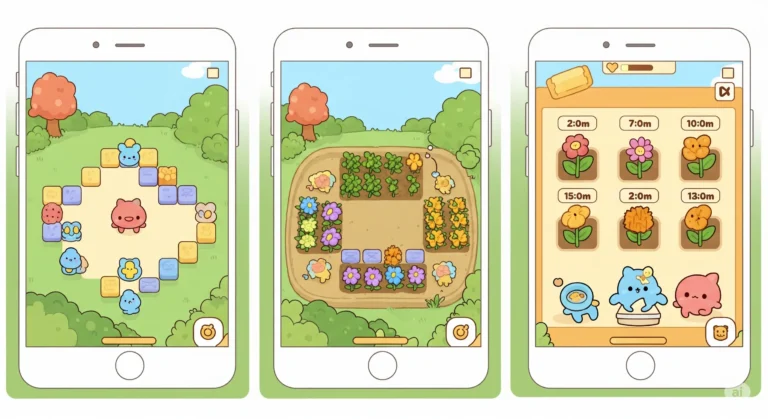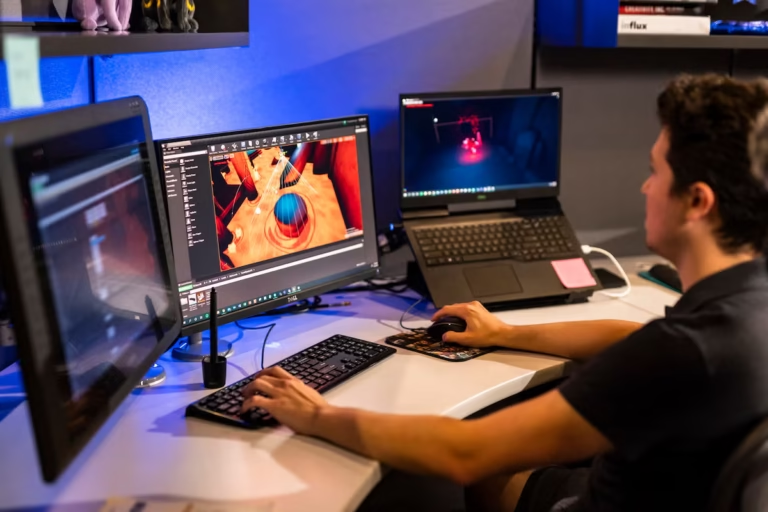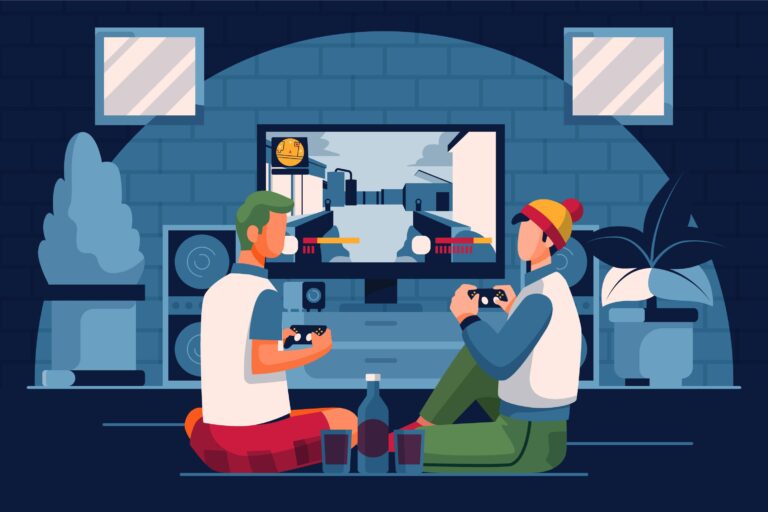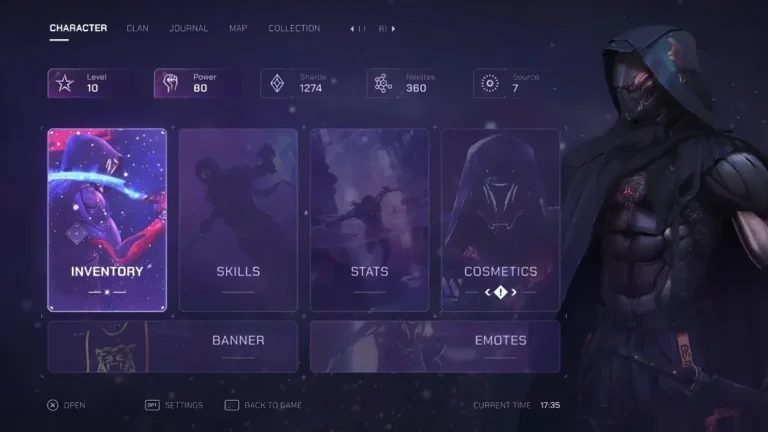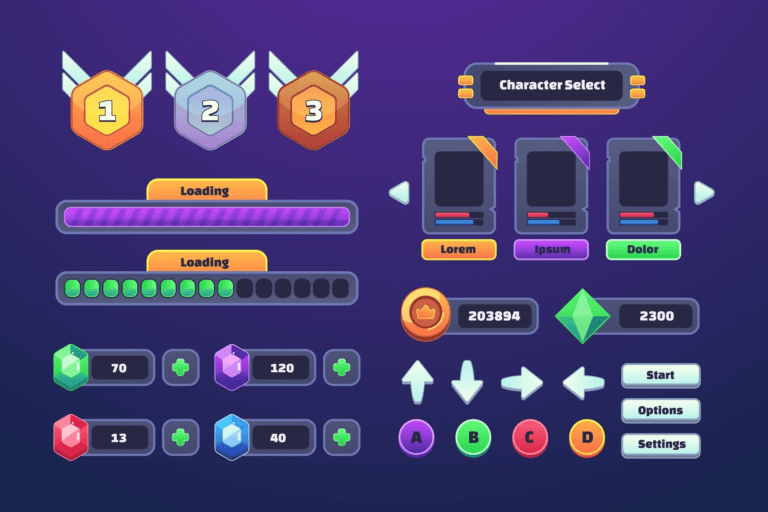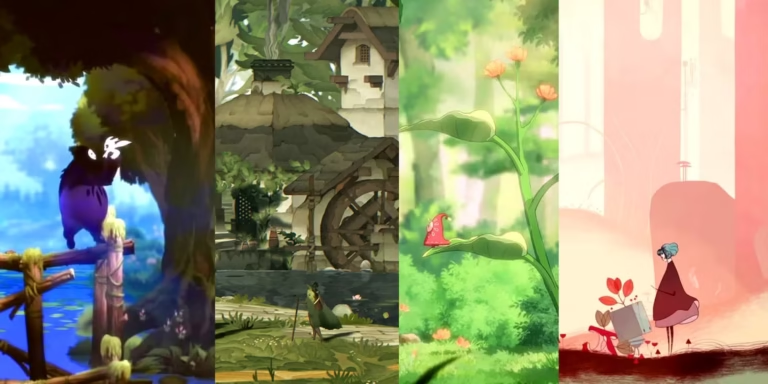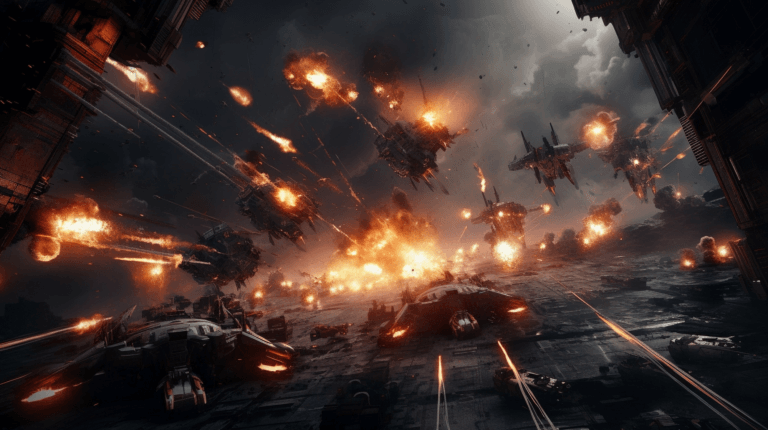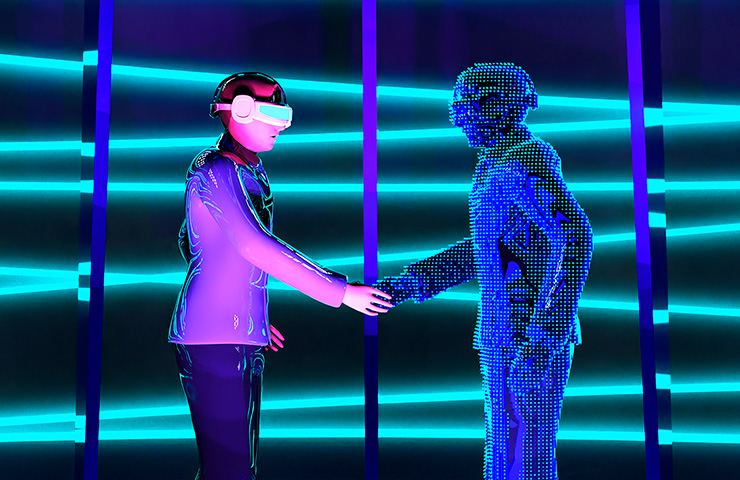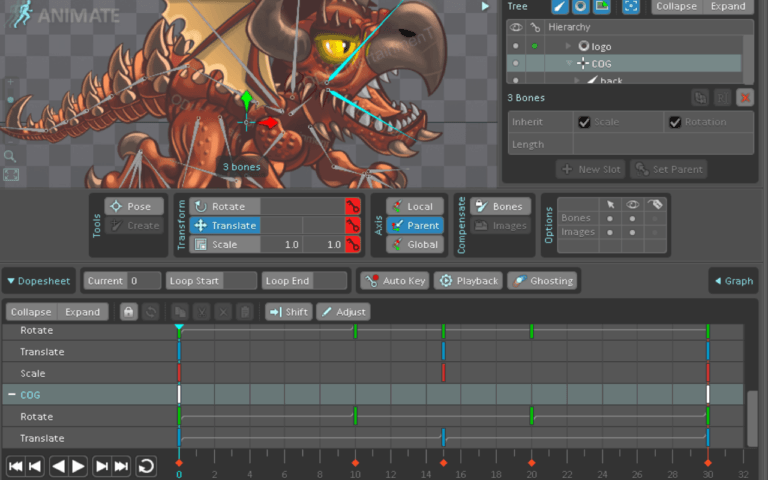A game art pipeline comes into play where a development team is going to develop the game’s vision from concept art and modeling to animating and rendering. The game art pipeline is the sequence of steps for creating and implementing visual assets in video game development. It typically includes concept art, 3D modeling, texturing, rigging, animation, and integration into the game engine. Various 2D and 3D game artists and designers work together to create engaging game art efficiently and effectively, keeping high quality.
In this blog, we will discover different stages of the game art production pipeline and how it helps to create successful video games.
What is a Game Art Pipeline?
A game art pipeline is a process that game developers follow to create visual assets for video games, including character design, game background design, UI design, and objects. It consists of particular steps and techniques that start with planning and conceptualizing and end with final testing and troubleshooting before the game’s release.


Need Game Art Services?
Visit our Game Art Service page to see how we can help bring your ideas to life!
What Are the Steps in Game Art Creation?
There are 3 steps in the game art creation. This production pipeline can be divided into 3 steps:
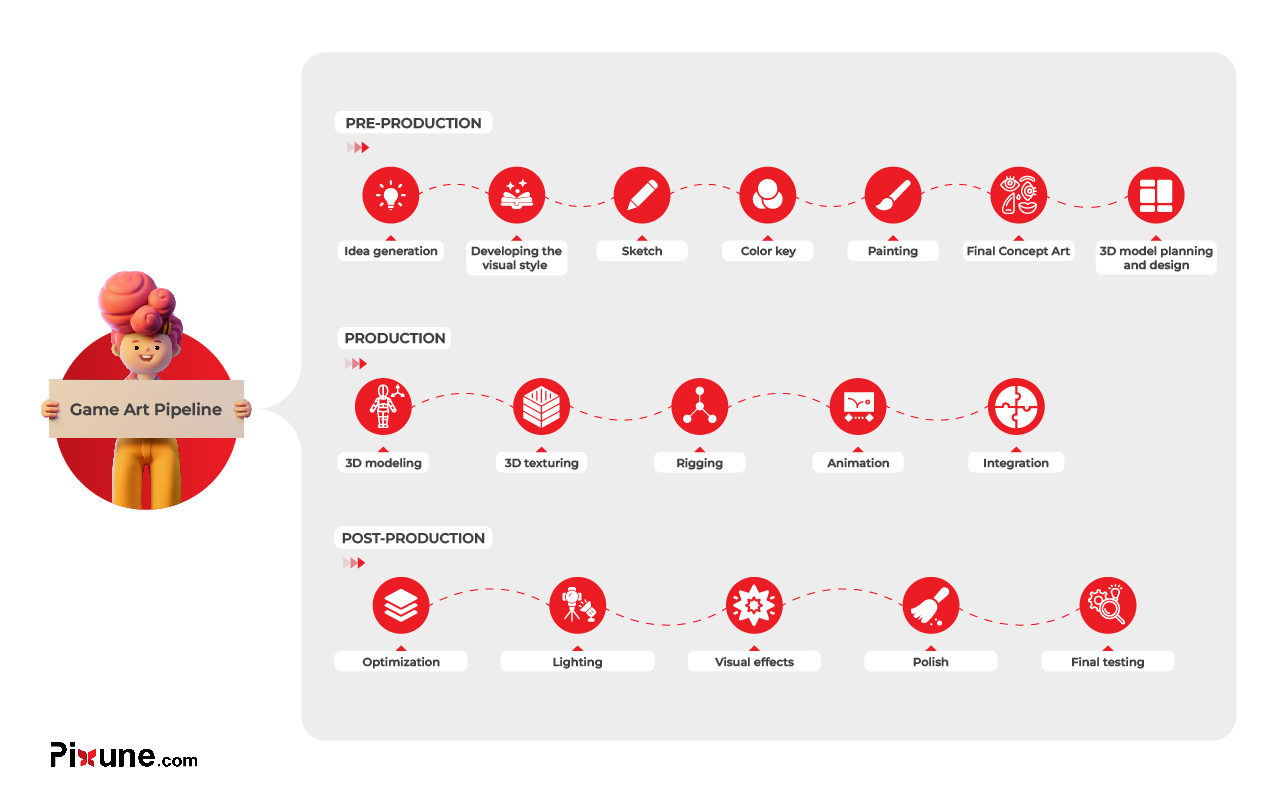
Game Art Pre-Production
This step is where the concept is created based on what you have in mind. As simple as it might sound, this step is fundamental and critical to the project.
The pre-production includes the following stages in the game art pipeline:
1. Idea Generation
Generating an idea is the most important stage of game art pre-production because you have to know where to start.
Brainstorming is a popular method for generating ideas. It involves gathering diverse people from various experiences and perspectives to develop unique ideas.
Another method for generating ideas is to undertake research and gather inspiration from various sources. Playing games to discover what works and what doesn’t, studying game art design trends, and performing market research can really help here.
2. Visual Style Development
This stage includes creating the game’s visual aesthetic, which includes the art direction, color scheme, and general aesthetic. The visual style should complement the story and character designs. In this stage, different game art styles are taken into account to determine which is best for the project.
What is Look Development?
Look development in a game art pipeline is the process of creating the visual style, texture, lighting, color, and the game’s aesthetic. It starts with concept art (sketch & paint) and involves creating 3D modeling, texturing and shading them and then applying lighting to the scene.
3. Sketch
After getting to know what the game should be, the first part of the concept art process is when the artists start drawing multiple sketches for characters, environments, and props. Sketches are what artists experiment with ideas and concepts before committing to a final design. Sketches can range from simple line drawings formed by shape language to more detailed drawings.
It’s important to know that sketches can include color, but it is not always necessary. However, adding color to these sketches can help communicate design aspects. Sketches can also be used to explore different visual styles and color palettes.
It is completely based on the game art studio and artists’ preferences; In contrast, other artists could use color in order to understand the design better; some prefer to work in black and white or grayscale so they can concentrate on the form and composition.

4. Color Key
The color key is a visual guidance used in the game art pipeline to set up the game’s color palette and mood in the concept art stage. Specific color schemes represent the intended tone and atmosphere for a consistent look and feel.
Here, the color palette, a collection of colors used together in a specific design, is ready based on the color theory in games. A typical color palette can include primary, secondary, and tertiary colors.
It’s important to consider how the colors fit different assets, such as characters, environments, and UI elements. It’s also important to consider how the colors look on different devices and displays in different lighting conditions and environments.

5. Painting
The last part of the concept art is applying colors to a surface using various tools and techniques for more detailed textures. During the pre-production of game art, painting is done on a digital table using tools like Adobe Photoshop or Procreate.
In addition to details, lighting & shading effects are also created by painting sketches. A skilled game artist can create visually compelling and appealing game art at this stage of the game art production pipeline.

Read More: Color definition in art
6. Final Concept Art
The final concept art is a refined version of the art with clear lines, light, and texture. This design must intend the visual style and mood of the game based on technical limitations and requirements. It serves as a blueprint for the rest of the game art pipeline process.
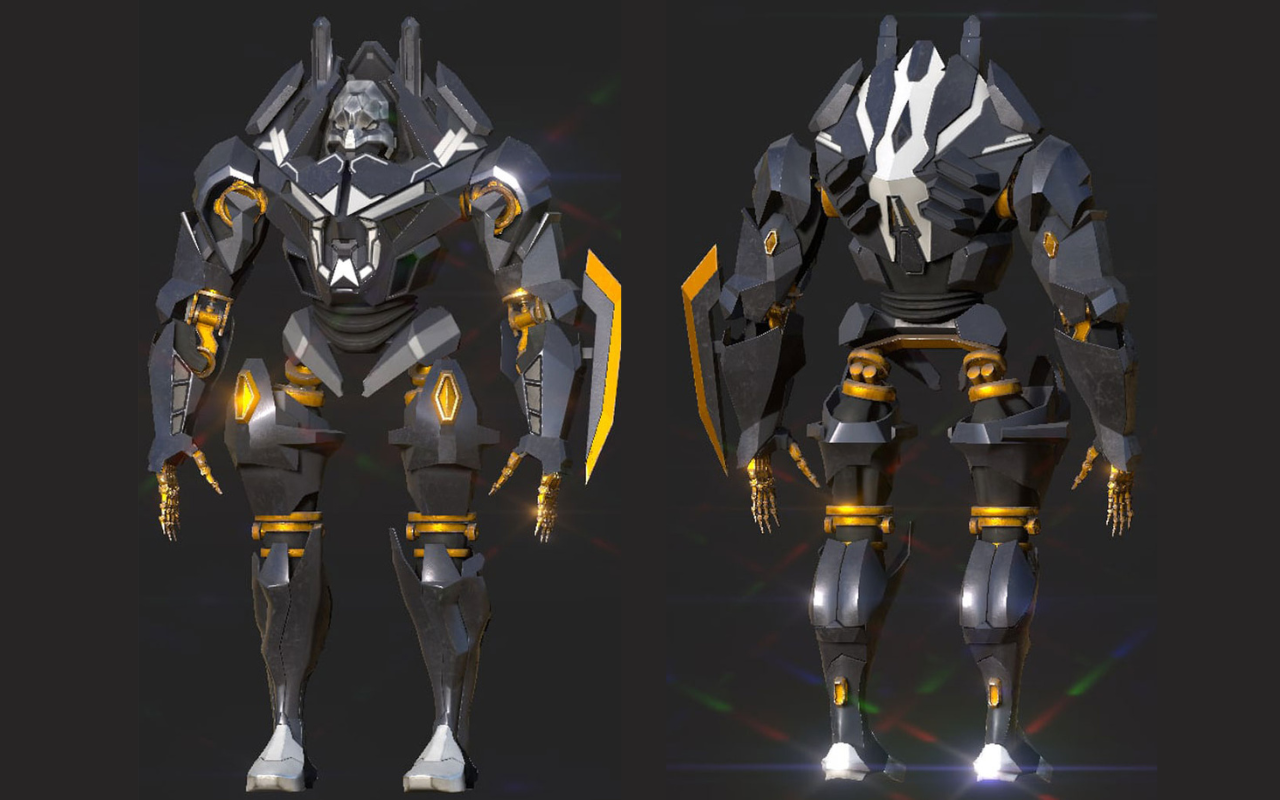
7. 3D Model Planning
During pre-production, the game development team plans and chooses the level of complexity of chosen 3D objects and environments and how the models will be optimized for the game engine.
Production Pipeline for Game Art
The actual game assets are created in this step, which is the most important step in the game art production pipeline, including 3D models, textures, rigging, animations, integration, and special effects.
1. 3D modeling
In 3D game modeling services, the chosen characters, game landscapes, and environments will get 3D treatments, and the artists will model the assets. There are 2 types of 3D modeling in the 3D game art pipeline:
Read More: 3D Modeling vs. Sculpting
High-Poly 3D Modeling
Creating high-detail models for cutscenes and promotional materials is done by using 3D modeling software such as Autodesk Maya or 3D Studio Max.
Low-Poly 3D Modeling for the Game Engine
Low-poly 3D modeling allows 3D models to be optimized for game engines because they must have fewer polygons than high-poly models and are used for in-game assets. If you want to read about the low-poly game art guide, click here.
2. 3D Texturing (If 3D)
Now, it’s time to optimize textures and apply 2D textures onto the surfaces of 3D models in order to add detail, color, and surface characteristics like roughness, glossiness, and bumpiness and enhance their visual appeal.
3D texturing involves creating textures using software such as Adobe Photoshop or Substance Painter and mapping them onto the 3D models.
3. Rigging
In the rigging process, the character or anything that needs motion and movement gets rigged and flexible joints and bones, which makes it possible for animators to apply animations later on. Creating a digital skeleton based on the human anatomy for the 3D models allows them to move.
4. Animation
This stage includes animating objects, environments, and character animation. While animating, creating movements through manipulating the digital skeleton created during the rigging process is done.
5. Integration and Debugging
Optimizing the assets for use in real-time game environments, setting up materials and textures, and adding animations and other effects are done in this stage. Here you can see how the created assets will look and behave in the game and identify and resolve the issues.
Post-Production in Game Art Pipeline
Post-production is the last step in a game art pipeline, where the game art assets are polished with visual effects, lighting, and sound effects.
Quality assurance and bug testing are also conducted here to ensure the game is ready for release.
1. Optimization
By reducing the number of polygons and textures used in the models, as well as adjusting the lighting and visual effects, you can make sure that the game runs smoothly on various hardware configurations.
2. Lighting
In order to achieve the desired result, lighting is added. This stage involves creating shadows, reflections, and other lighting effects based on what was decided in pre-production.
3. Visual effects (VFX)
VFX like particle effects and explosions are also created during this step. These visual elements within a game include dynamic lighting and shadows, weather effects such as rain and snow, explosions and smoke, and magic effects.
4. Polish
Refining and perfecting a game’s user experience (UX) through various design and technical improvements is called polish in the game art production pipeline. The goal is to create engaging, user-friendly art and see the game’s overall presentation and aesthetics.
5. Final Testing
Final testing before release helps to ensure that the game is technically sound, playable, and enjoyable for players. In addition to technical testing and the game’s performance under different conditions, final testing may also involve gathering feedback from focus groups and beta testers.
2D vs. 3D Game Art Pipeline
The main difference between a 2D game art pipeline and a 3D game art pipeline is the approach to creating and integrating art assets into the game. The art styles for 2D and 3D games can be different as well. 2D games are more likely to be cartoons; however, 3D games look more realistic.
Read More: 2D vs. 3D Games
Software and Game Engines
Artists create game assets in a 2D game art pipeline using software like Adobe Photoshop or Illustrator. These created assets will be imported into the game engine as 2D images and arranged on a 2D plane.
In contrast, a 3D game art pipeline involves creating assets using 3D modeling software like Maya or Blender to apply textures and other visual effects. These 3D assets will be imported into the game engine, rendered in real-time, and manipulated in 3D space.
Workflow
The workflow for each 2D or 3D also differs in game art companies. For example, 2D artists put more focus on creating concept art and sketches, while 3D artists put more focus on creating detailed 3D models and animations.
Conclusion
To sum up, a game art pipeline is a process of creating visual assets like characters, environments, UI, weapons, vehicles, etc. The production pipeline comprises 3 steps, pre-production, production, and post-production, and inclusive from ideas generation to optimization. By following this process, the project will result in successful video games that are visually appealing to players.
